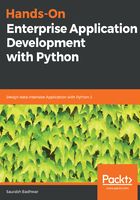
Object-oriented Python
Object-oriented programming (OOP) refers to the organization of code in a format where we are not concerned with the organization of methods, but rather we are concerned with the objects, their properties, and their behavior.
An object may represent any logical entity, such as an animal, vehicle, and furniture, and will contain properties and behaviors describing them.
The basic building block of an OOP-based language is the class that often groups the logically related entities together into a single unit. When we need to work with this unit, we create a new instance of this unit known as the class object, and manipulate the object using the public interfaces exposed by the object.
Object-oriented programming in Python differs quite a lot from what a person might see in C++ or Java, and these differences also affect the way in which we implement the different design patterns in Python. Let's take a look at how Python's object-oriented model can affect the implementation of different design patterns, and what other functionality the language provides to ease out on some of the tasks.